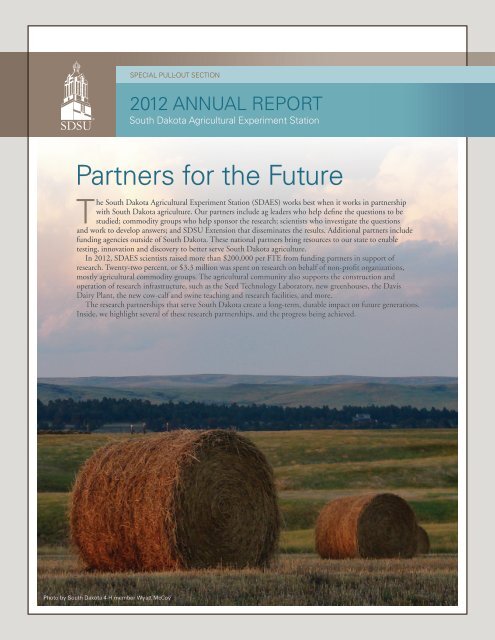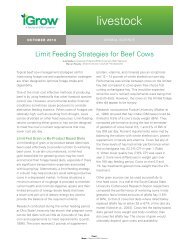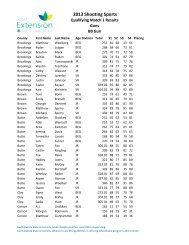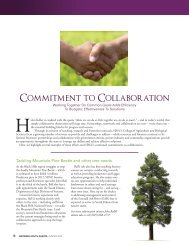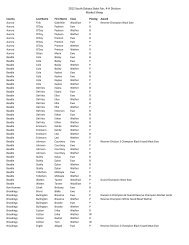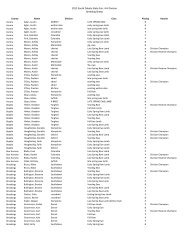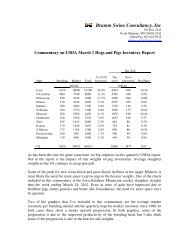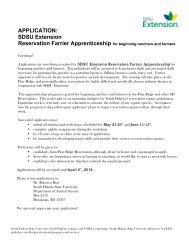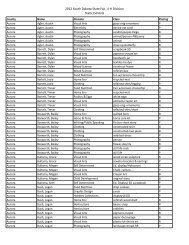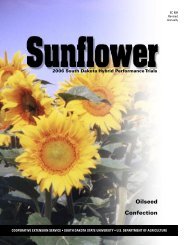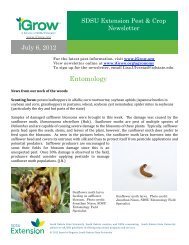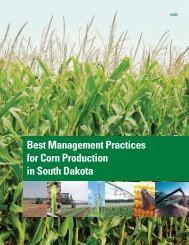Annual Report - iGrow
Annual Report - iGrow
Annual Report - iGrow
You also want an ePaper? Increase the reach of your titles
YUMPU automatically turns print PDFs into web optimized ePapers that Google loves.
www.sdstate.edu/abs<br />
Partners for the Future<br />
The South Dakota Agricultural Experiment Station (SDAES) works best when it works in partnership<br />
with South Dakota agriculture. Our partners include ag leaders who help define the questions to be<br />
studied; commodity groups who help sponsor the research; scientists who investigate the questions<br />
and work to develop answers; and SDSU Extension that disseminates the results. Additional partners include<br />
funding agencies outside of South Dakota. These national partners bring resources to our state to enable<br />
testing, innovation and discovery to better serve South Dakota agriculture.<br />
In 2012, SDAES scientists raised more than $200,000 per FTE from funding partners in support of<br />
research. Twenty-two percent, or $3.3 million was spent on research on behalf of non-profit organizations,<br />
mostly agricultural commodity groups. The agricultural community also supports the construction and<br />
operation of research infrastructure, such as the Seed Technology Laboratory, new greenhouses, the Davis<br />
Dairy Plant, the new cow-calf and swine teaching and research facilities, and more.<br />
The research partnerships that serve South Dakota create a long-term, durable impact on future generations.<br />
Inside, we highlight several of these research partnerships, and the progress being achieved.<br />
Photo by South Dakota 4-H member Wyatt McCoy<br />
SPECIAL PULL-OUT SECTION<br />
2012 ANNUAL REPORT<br />
South Dakota Agricultural Experiment Station<br />
WINTER 2013 GROWING SOUTH DAKOTA 7
2012 ANNUAL REPORT<br />
South Dakota Agricultural Experiment Station<br />
Partners in new product development<br />
Development of economical soy-based<br />
fish feed could tap a new market for<br />
South Dakota soybean producers – and<br />
commercial fish production entities.<br />
Through a partnership with the SD<br />
Soybean Research and Promotion Council,<br />
South Dakota Agricultural Experiment<br />
Station scientists Michael Brown from<br />
SDSU’s Department of Natural Resource<br />
Management and William Gibbons<br />
from SDSU’s Department of Biology<br />
and Microbiology have joined forces to<br />
develop soymeal as a protein component in<br />
commercial fish feed.<br />
Currently commercial fish farms must<br />
rely on feeds containing fish meal as a<br />
protein source - with prices from $1,500<br />
to $1,800 per ton. By replacing fish meal with sustainable<br />
plant-based protein products, Gibbons and Brown say they<br />
can decrease the cost of feed, expand opportunities for valueadded<br />
products from soybeans and increase profitability for<br />
fish farms.<br />
Partners in human nutrition and livestock production<br />
Red meat often gets a bad<br />
rap when it comes to a<br />
heart healthy diet, but the<br />
South Dakota Beef Industry<br />
Council (SDBIC) aims<br />
to change that perception<br />
through its beef checkofffunded<br />
partnership with<br />
South Dakota Agricultural<br />
Experiment Station researcher<br />
Kendra Kattelmann.<br />
Kattelmann, a SDSU<br />
professor of health and<br />
nutritional sciences, evaluated how consuming an additional<br />
7 to 9 ounces of lean beef affects iron status. A total of seven<br />
graduate students worked on the one-year projects. The first<br />
two projects tracked a total of 51 physically active females<br />
over a 10-week period, while the third looked at 34 collegiate<br />
athletes competing in volleyball or cross-country (pictured)<br />
during an 8-week period.<br />
From the research, Kattelmann and her students<br />
concluded: 1) A high protein diet does not negatively affect<br />
a woman’s bone density; and 2) Long-distance runners who<br />
supplemented their diets with lean beef retained more lean<br />
body mass during the season than those who did not consume<br />
To accomplish this goal, Gibbons<br />
transforms the soybean meal into a form that<br />
the fish can more easily digest. Then Brown<br />
(pictured with SDSU Wildlife and Fisheries<br />
student Tabor Martin from Canton, SD)<br />
determines the percentage of soy product<br />
that can be used to replace the marinederived<br />
protein, yet maintain a nutritionally<br />
balanced diet for the fish. The project,<br />
which began in 2011, will receive about<br />
$1.7 million over three years from the SD<br />
Soybean Council and United Soybean Board<br />
through the producers’ checkoff system.<br />
As the global population continues to grow<br />
– along with demand for fish and shellfish,<br />
development of this economical soy-based<br />
fish feed offers opportunities for expanding<br />
the fish production industry here in South Dakota and across<br />
the county.<br />
Of the effort, Doug Hanson of Elk Point, who is the South<br />
Dakota Soybean Council’s aquaculture liaison, says, “We just<br />
need research that shows it’s profitable for investors to look at<br />
it really seriously.”<br />
the extra protein. Even though<br />
the amino acids consumed<br />
were the same, Kattelmann<br />
says, “The use of lean beef<br />
attenuated the loss of lean<br />
tissue.” This was not the case<br />
for volleyball players, but<br />
Kattelmann explains that the<br />
aerobic nature of running<br />
could account for<br />
the difference.<br />
Kattelmann’s next project<br />
with the SDBIC will be<br />
to evaluate how eating lean beef affects adults at risk for<br />
developing heart disease, stroke and type 2 diabetes. She is<br />
working with Avera Heart Hospital to recruit and monitor<br />
40 participants for the three-month study which will begin<br />
in 2013.<br />
Of the research partnership, Holly Swee, the SDBIC’s<br />
Director of Nutrition and Consumer Information says,<br />
“The Council is focused on funding science-based research<br />
to support the benefits of beef ’s high quality protein in a<br />
healthful diet… We believe this checkoff-funded research will<br />
benefit both beef producers and consumers in South Dakota<br />
and beyond.”
FROM THE DIRECTOR: DANIEL SCHOLL<br />
Providing Knowledge, Information & Technologies<br />
As we reflect on 2011 and 2012, we are quickly reminded of some of the challenging conditions that<br />
South Dakota farmers, ranchers and the state population as a whole confront. Variability in weather,<br />
domestic and global politics, markets, and public opinion all influence the status of the South Dakota<br />
agriculture economy and South Dakota communities.<br />
It is in this context that the South Dakota Agricultural Experiment Station (SDAES) strives to provide knowledge,<br />
information and technologies to help South Dakota agricultural businesses and communities make the decisions that are optimal<br />
for their well-being.<br />
During this last year, we celebrated the 150th anniversary of the Morrill Act (1862) which established land-grant universities<br />
such as SDSU. Representative Justin Morrill specifically recognized declining productivity of colonial farm lands and envisioned<br />
active state-specific agriculture research programs to improve our ability to feed ourselves. Agriculture Experiment Stations were<br />
established at land-grant universities with the passage of the Hatch Act (1887) to continue the effort.<br />
The SDAES has a long and productive history, and I am excited to share some highlights of SDAES research in this<br />
<strong>Annual</strong> <strong>Report</strong>.<br />
Central to the SDAES approach of identifying relevant research questions and acquiring the additional funds that conducting<br />
the research requires are the strong partnerships we have with South Dakota’s agriculture organizations. We could not serve South<br />
Dakota effectively without the ever-strengthening partnerships, sponsorships and communications we have with these groups.<br />
Finally, I would like to recognize the dedicated and effective work done by our faculty. To conduct the research that SDSU is<br />
known for, our faculty raise external research funds equal to over 250% of their salary each year. This is just one example of their<br />
hard work and intellectual leadership. It is a pleasure to work with this stellar group of professionals.<br />
Partners in wheat production and economic development<br />
Higher yields, increased grain protein<br />
and greater disease resistance top South<br />
Dakota wheat farmers’ wish list when<br />
it comes to traits they want, according<br />
to the 2011 Wheat Variety Survey.<br />
Through partnerships with the SD Wheat<br />
Commission and Bayer CropScience,<br />
Agricultural Experiment Station scientists<br />
in the state are working to fulfill these needs<br />
and make an end product that is as tasty as<br />
it is healthy.<br />
SD Wheat Commission is a long-time<br />
partner that has been funding research at<br />
SDSU for more than 50 years. About 40%<br />
of each year’s wheat checkoff funds go to<br />
SDSU research projects, amounting to<br />
about $600,000 per year, though not all of<br />
it goes to the breeding program.<br />
As an example of current research, molecular genetics<br />
techniques are being utilized by SDSU plant geneticist Jose<br />
Gonzalez who collaborates with spring wheat breeder Karl<br />
Glover, winter wheat breeder William Berzonsky, and cereal<br />
chemist Padu Krishnan on projects to identify and use the<br />
genes responsible for resistance to fusarium head blight, stem<br />
rust and orange blossom wheat midge.<br />
Krishnan and his four graduate students also evaluate the<br />
consumption quality of the wheat crop at his lab in the Seed<br />
Technology facility.<br />
Pictured: SDSU post-doc researcher Melanie<br />
Caffe-Treml pollinates wheat with corn pollen<br />
as the first step in creating a doubled-haploid.<br />
This technique is expected to reduce the<br />
time it takes to develop a new variety by<br />
approximately two years.<br />
Bayer CropScience is a newer partner<br />
collaborating with SDSU wheat researchers.<br />
Over the last three years, Berzonsky has<br />
been working with Bayer CropScience and<br />
Ducks Unlimited on the Winter Cereals:<br />
Sustainability in Action project, which aims<br />
to enhance the habitat for wildlife in the<br />
Prairie Pothole Region. Waterfowl have a<br />
24 times higher chance of hatched nests in<br />
winter cereals than in spring planted. Thus,<br />
the goal of their effort is to develop better<br />
cold tolerance in winter wheat.<br />
To develop new wheat varieties faster, a doubled-haploid<br />
technique that takes approximately two years off the 10-year<br />
breeding process is being used.<br />
In 2011, SDSU expanded its relationship with Bayer<br />
CropScience by signing a non-exclusive agreement that gives<br />
the company access to a selection of SDSU’s spring wheat<br />
germplasm. The scientists say this will allow South Dakota<br />
breeding materials to reach a wider market, and the support<br />
will eventually create an endowment to further strengthen<br />
the program.
2012 ANNUAL REPORT<br />
South Dakota Agricultural Experiment Station<br />
Our Foundation –<br />
The Morrill Act<br />
As we look back 150 years and recognize the brilliant<br />
foresight and leadership of Justin Morrill, the U.S. Congress,<br />
and President Abraham Lincoln, we recognize their efforts<br />
to create hope and opportunity during the darkest days of<br />
the Civil War. Our nation was being torn apart, but these<br />
visionary leaders worked to lay the groundwork that would<br />
establish the system of land- grant universities, and create the<br />
Hatch Act that established Agricultural Experiment Stations.<br />
This early legislation opened the doors for publically<br />
supported agricultural research in each state, including South<br />
Dakota. Today, our partners and our highly-qualified faculty<br />
keep that research mission alive and effective.<br />
Continuing For The Future<br />
Our generation bears the responsibility of providing the tools<br />
of prosperity for future generations. The food production<br />
capacity and profitability that future generations will enjoy is<br />
based on the research occurring today. Just as Justin Morrill<br />
and Abraham Lincoln set the stage for the science of today,<br />
so too we must work to assure that objective and unbiased<br />
research is available to future generations. Together, we can<br />
assure that South Dakota farmers and ranchers meet the<br />
world’s needs through economically sustainable and efficient<br />
agricultural production and bioscience innovation.<br />
10 GROWING SOUTH DAKOTA WINTER 2013<br />
AES External Research Funds – Fiscal year 2012<br />
Actual Expenditures<br />
Total $14,788,635<br />
PRIVATE<br />
$571,797<br />
NON-PROFIT<br />
$3,295,092<br />
4% 3%<br />
22%<br />
71%<br />
STATE<br />
$496,210<br />
FEDERAL<br />
$10,425,536


